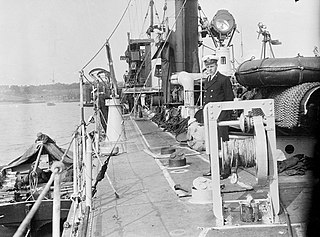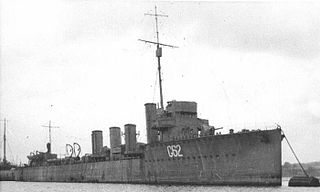
HMS Ambuscade was an Acasta-class destroyer of the Royal Navy and was launched in 1913. She served throughout the First World War, forming part of the Grand Fleet and taking part at the Battle of Jutland, serving in the Dover Patrol and spending the latter part of the war as a convoy escort. She was sold for scrapping in 1921.

HMS Lance was a Laforey-class destroyer of the Royal Navy. Launched a few months before the outbreak of the First World War and attached to the Harwich Force, Lance took part in several engagements during the war, including the sinking of the Königin Luise and the Battle off Texel. She was responsible for firing the first British shot of the war.

HMS Laforey was the lead ship of her class of destroyer built for the Royal Navy. Launched a year before the First World War began, she was attached to the Dover Patrol. Laforey saw action in several engagements with German torpedo boats, including the Battle off Noordhinder Bank and the action of 17 March 1917. Laforey was sunk in 1917 by a British mine after escorting several freighters to France. She was named for Francis Laforey, captain of HMS Spartiate at the Battle of Trafalgar in 1805.
HMS Faulknor was a British destroyer of the First World War. She was purchased by the Royal Navy whilst still under construction in Britain for the Chilean Navy who had ordered her in 1912 as part of the Almirante Lynch class. She was renamed after the Faulknor family of British nineteenth century naval officers.

The Harwich Force originally called Harwich Striking Force was a squadron of the Royal Navy, formed during the First World War and based in Harwich. It played a significant role in the war.
Chios was a Medea-class destroyer laid down for the Greek Navy by Fairfield Shipbuilding and Engineering Company, Govan in 1914. She was launched as 16 December 1914 and completed for service in the Royal Navy as HMS Melampus on 29 June 1915. On 16 April 1917 she accidentally rammed and sank the C-class submarine C16. She was sold for breaking up on 22 September 1921.

HMS Meteor was a Thornycroft M-class destroyer that served in the British Royal Navy. Meteor saw extensive service throughout World War I, maintaining continuous operations both as a convoy escort and in harbour protection.

HMS Porpoise was an Acasta-class destroyer of the Royal Navy, which was built by Thornycroft between 1912 and 1914. Porpoise served through the First World War, taking part at the Battle of Jutland in 1916, where she was damaged. In 1920, she was sold to the Brazilian Navy serving under the name Alexandrino de Alencar and was renamed Maranhão in 1927. Maranhão remained in service when Brazil entered the Second World War, being used for patrol and convoy duties. She was disposed of in 1945.

HMS Marksman was a Marksman-class flotilla leader of the British Royal Navy. Construction at Hawthorn Leslie's Newcastle upon Tyne shipyard began in 1914, shortly before the outbreak of the First World War, and the ship was launched and completed in 1915. She took part in the Battle of Jutland in 1916 and survived the war. She was sold for scrap in 1921.
HMS Murray was a Royal Navy Admiralty M-class destroyer. Ordered before the outbreak of war, she was therefore the first of her class to enter operation during the early months of the First World War. She was also the first vessel of the Royal Navy to carry the name HMS Murray.

HMS Nimrod was a Marksman-class flotilla leader of the British Royal Navy. She was built by the Scottish shipbuilder Denny, with construction starting in 1914 and completed in August 1915. She served through the remainder of the First World War. She was sold for scrap in 1921.
HMS Lightfoot was a Marksman-class flotilla leader of the British Royal Navy. Construction by J. Samuel White began in June 1914, shortly before the outbreak of the First World War, and the ship was launched and completed in 1915. She survived the war and was sold for scrap in 1921.

HMS Rob Roy was a Royal Navy R-class destroyer constructed and then operational in the First World War. The ship served in the Grand Fleet as part of the Fifteenth Destroyer Flotilla.
HMS Mentor was a Hawthorn Leslie M-class destroyer of the British Royal Navy. Built by the Tyneside shipbuilder Hawthorn Leslie between 1913 and 1915, Mentor served during the First World War. She formed part of the Harwich Force in the early years of the war, taking part in the Battle of Dogger Bank and then later in the English Channel as part of the Dover Patrol. She survived the war, and was sold for scrap in 1921.

HMS Landrail was a Laforey-class destroyer of the British Royal Navy. The Laforey class was the class of destroyers ordered under the Royal Navy's 1912–1913 construction programme, which were armed with three 4-inch (102 mm) guns and four torpedo tubes and were capable of 29 knots. The ship, which was originally to be named Hotspur but was renamed before launch, was built by the Scottish shipbuilder Yarrow between 1912 and 1914,
HMS Lark was a Laforey-class destroyer of the British Royal Navy. The Laforey class was the class of destroyers ordered under the Royal Navy's 1912–1913 construction programme, which were armed with three 4-inch (102 mm) guns and four torpedo tubes and were capable of 29 knots. The ship, which was originally to be named Haughty but was renamed before launch, was built by the Scottish shipbuilder Yarrow between 1912 and 1913.

HMS Matchless was a Royal Navy Admiralty M-class destroyer. Matchless was built by Swan Hunter from 1913 to 1914 and was completed in December that year. She served through the remainder of the First World War, operating in the North Sea as part of the Harwich Force in the early part of the war and later in the English Channel as part of the Dover Patrol, where she took part in both the First and Second Ostend Raids. Despite being badly damaged by a German mine in 1915 and being involved in several collisions, she survived the war, and was sold for scrap in 1921.
HMS Milne was a Royal Navy Admiralty M-class destroyer. Milne was built by John Brown & Company from 1913 to 1914 and was completed in December that year. She served through the remainder of the First World War, at first with the Harwich Force with which she took part in the Battle of Dogger Bank in January 1915, and later with the Dover Patrol, sinking the German submarine UC-26 in May 1917. Milne was sold for scrap in 1921.
HMS Melpomene was a Medea-class destroyer of the British Royal Navy. She was one of four destroyers, of similar design to the British M-class ordered by Greece in June 1914, which the British purchased during construction owing to the outbreak of the First World War.

HMS Lawford was a Laforey-class destroyer of the British Royal Navy. The Laforey class was the class of destroyers ordered under the Royal Navy's 1912–1913 construction programme, which were armed with three 4-inch (102 mm) guns and four torpedo tubes and were capable of 29 knots. The ship, which was originally to be named Ivanhoe but was renamed before launch, was built by the Scottish shipbuilder Fairfields between 1912 and 1914.











